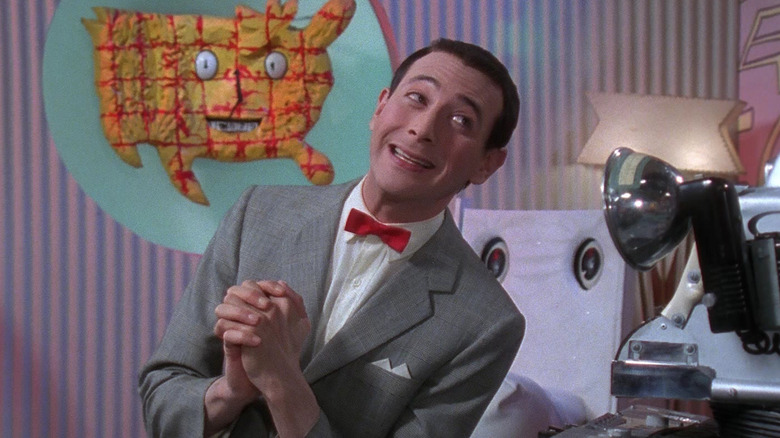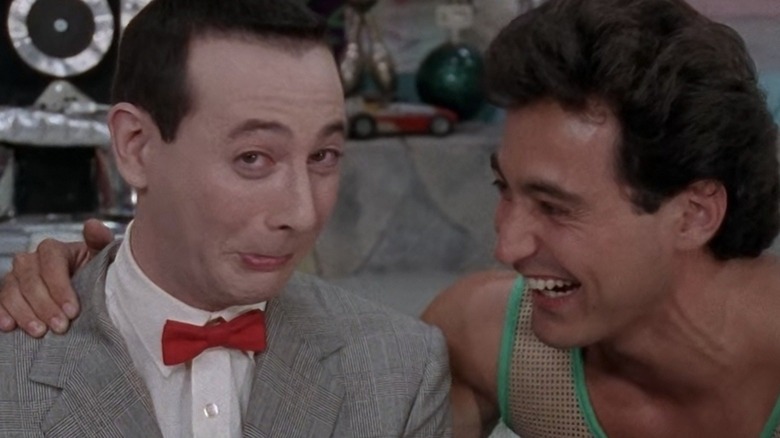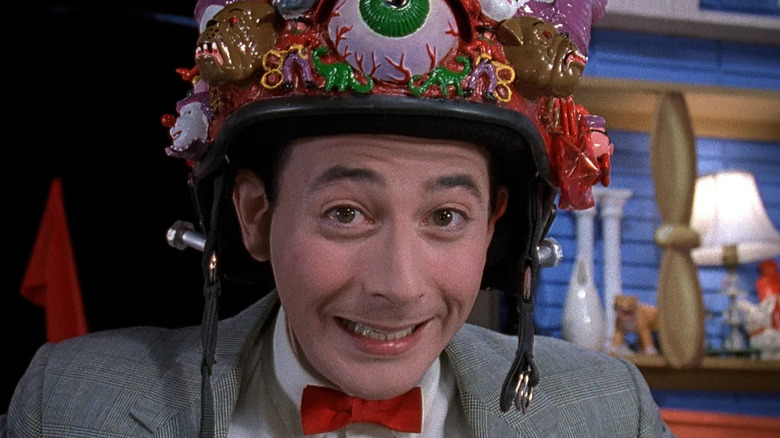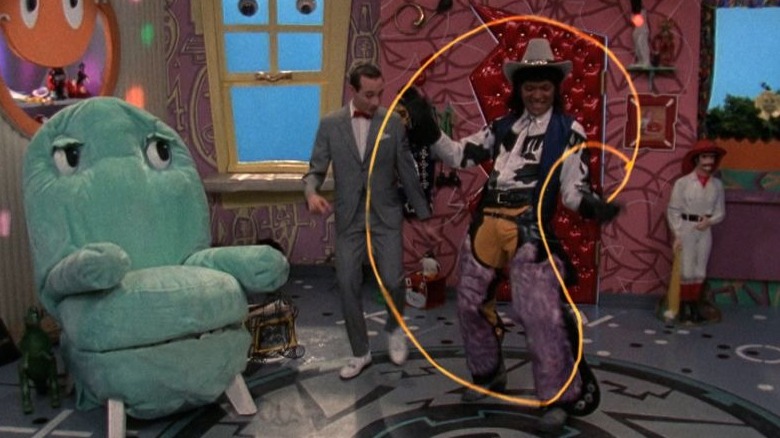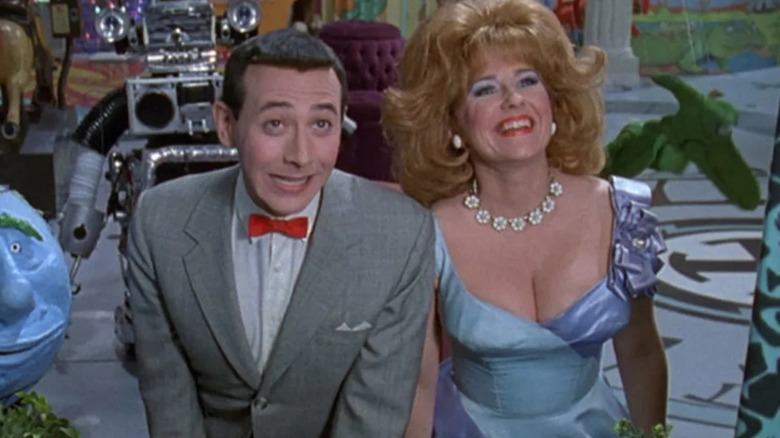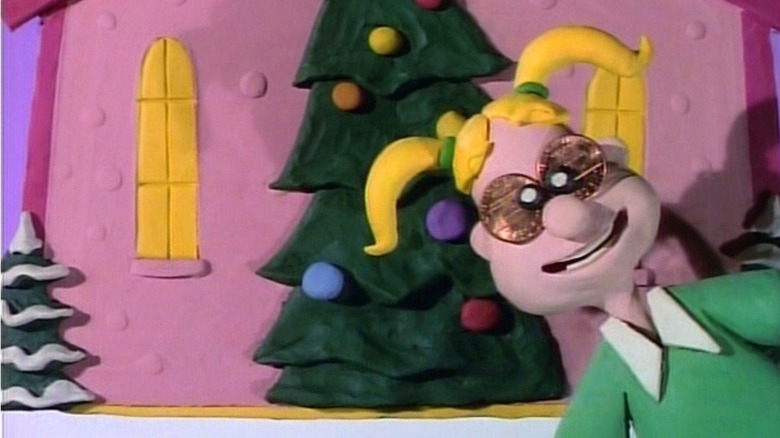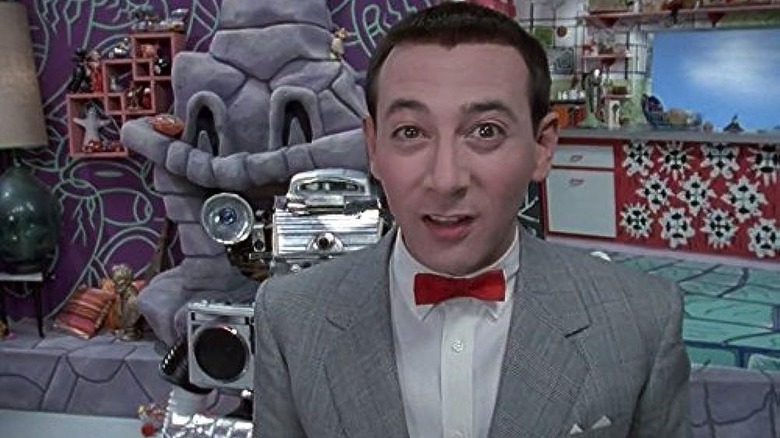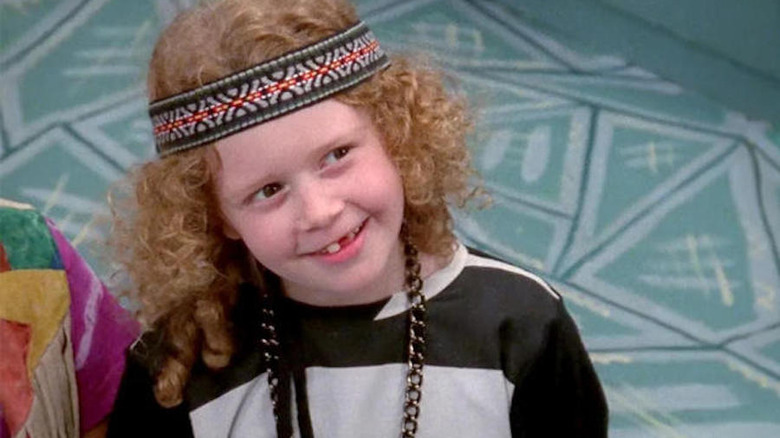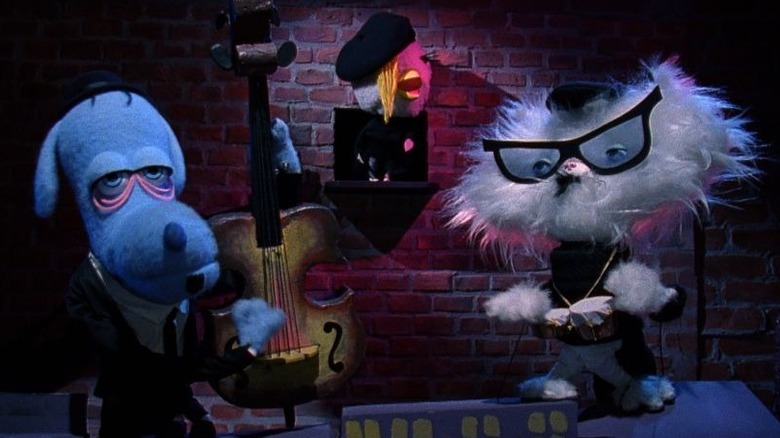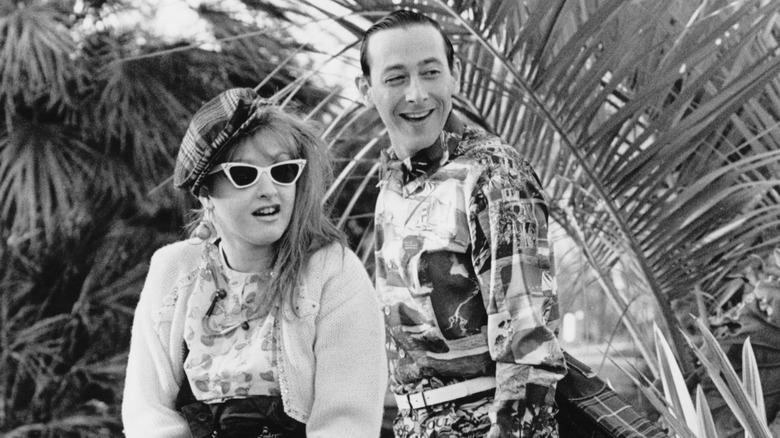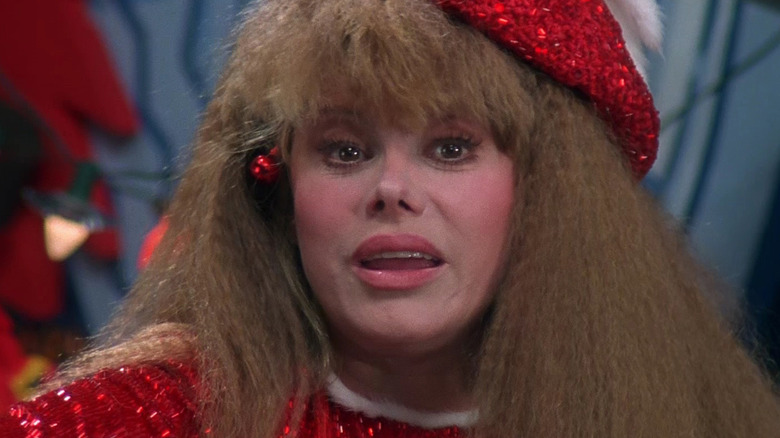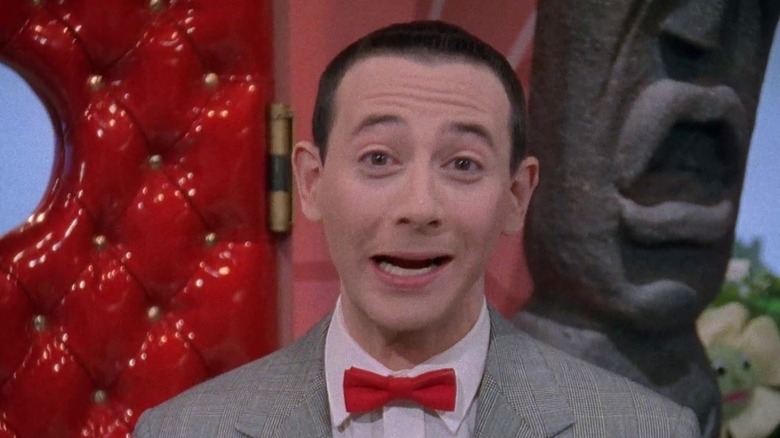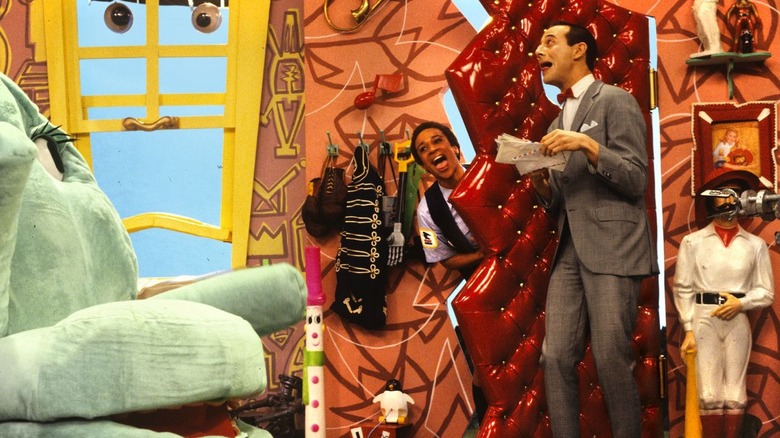Things Only Adults Notice In Pee-Wee's Playhouse
"Pee-wee's Playhouse" is a beloved children's show that first aired in the mid-1980s. It was hosted by one of the most unique TV stars of all time in Pee-Wee Herman, the on-stage persona of the late actor and comedian Paul Reubens. The series began life as a one-off HBO special before running for nearly 50 episodes on CBS between 1986 and 1990. The show made its mark on pop culture and is still appreciated by many today thanks to its vibrant and whimsical wonder.
At first glance, "Pee-wee's Playhouse" may appear to be little more than a chaotic blend of colorful sets, oddball puppets, and human actors engaged in energetic antics aimed squarely at young viewers. However, it also had its share of adult viewers who appreciated it for its quirky charm — and who saw much more than kids ever could. Beneath the surface was a hidden layer of sophistication, from veiled social commentary to cleverly disguised adult jokes.
So, come on in, pull up a chair, and let the fun begin, because we're diving into the things that only the adults notice about "Pee-wee's Playhouse."
It had a diverse cast
Thanks to the efforts of producers such as Norman Lear (creator of "Sanford and Son," "The Jeffersons," and several other sitcoms), networks were attempting to introduce more diversity into television by the time "Pee-wee's Playhouse" came about. In general, kids TV lagged behind in this area, but "Pee-wee's Playhouse" was an outlier in almost every way, and one of those ways was its diverse cast of actors and characters.
From African American characters like Cowboy Curtis (Laurence Fishburne) to the shirtless Latino lifeguard Tito (Roland Rodriguez), there seemed to be a deliberate emphasis on diversity in the cast. The fact that Tito departed the series after its first year and was replaced in Season 2 with soccer player Ricardo (Vic Trevino) suggests the show's multi-cultural cast was intentional. Women were also an important part of the show, and while Yvonne (Lynne Marie Stewart) may have been a bit cliched as the swooning, lovelorn, buxom babe, there were plenty of strong female roles, too.
From Reba the Mail Lady (S. Epatha Merkerson) to Dixie the Cabbie (Johann Carlo), the show's use of female actors demonstrated gender equality. And the diversity goes beyond recurring regulars, because even single-episode guest stars like Japanese American actor Joey Miyashima helped normalize diversity to an audience of kids. They may not have realized it, but the grown-ups watching with them probably took notice.
It stood on the shoulders of giants
Saturday mornings and weekday afternoons were littered with action-orientated cartoons like "Transformers," "ThunderCats," and "Teenage Mutant Ninja Turtles" in the 1980s, so a zany, live-action series like "Pee-wee's Playhouse" was able to stand out. It was unlike anything else on the air, and it was the type of weird, off-the-wall program that was hard to look away from. For kids in the audience, it probably seemed like it was wholly original, the first show of its kind. After all, nobody under the age of 12 had seen anything quite like this before.
Adults, however, probably noticed that the show had a lot in common with '50s classics like "The Pinky Lee Show," which featured a strikingly similar goofball host, and "The Howdy Doody Show," named for its wooden puppet host. The New York Times pointed to the many similarities when Paul Reubens died in 2023, writing, "Pee-wee the character was a parody — a high-on-Pixy-Stix exaggeration of the clean-cut kids' hosts of the 1950s, a Howdy Doody who brought himself to life."
Sure, "Pee-wee's Playhouse" dressed up the children's variety show and pushed it to extremes, but it wasn't as wholly original as many kids may have thought. With a set that bordered on a dreamscape and characters that seemed to spring to life from a child's vivid imagination, it might not have looked anything like its predecessors, but those of a certain age will have no doubt noticed that "Pee-wee's Playhouse" was a loving homage to the kids shows of yesteryear.
It featured some future superstars
It's no secret by now that "Pee-wee's Playhouse" featured a bunch of actors who went on to become big stars. One of the first people that Reubens recruited was Phil Hartman, a good friend of his from their days in the Groundlings improv group together. This was before Hartman's days as a cast member on "Saturday Night Live," where he'd become one of the funniest performers on television. He played Captain Carl in "Pee-wee's Playhouse" early in its run, but he was far from the only future star on the series.
Most famously, future Academy Award-nominee Laurence Fishburne played the iconic role of Cowboy Curtis, a goofy, old-timey, lasso-swinging cowpoke who would visit Pee-wee frequently. There was also Reba the Mail Lady, played by S. Epatha Merkerson, who is today best known for her long-running roles on network procedurals "Law & Order" (where she played Lt. Anita Van Buren for more than a decade) and "Chicago Med" (as Chief Sharon Goodwin).
For kids, these actors were just like anyone else on the series, but even during the show's run, adults were noticing the supporting cast of "Pee-wee's Playhouse" hitting the spotlight elsewhere. Fishburne in particular started making inroads in Hollywood, nabbing roles in movies like "A Nightmare on Elm Street 3: Dream Warriors," "Red Heat," and the Charlie Sheen-led Army drama "Cadence" — not films for children.
It contained some seriously steamy jokes
Finding adult jokes in a show for kids isn't all that unusual, especially when you're looking at shows that aired in the '80s, but "Pee-wee's Playhouse" often took it further than most. It really shouldn't come as much of a surprise, though, considering that Pee-wee Herman started out as a decidedly adult-skewing character who appeared first in the R-rated comedy "Cheech and Chong's Next Movie," spewing obscenities with regularity. When he got his own show, this time aimed at an audience of children, Reubens toned the humor down considerably, but he still found ways of sneaking in some dirty jokes for the grown-ups watching.
Most of the steamy jokes in "Pee-wee's Playhouse" relate to Yvonne, who is written as a big flirt. For example, she asks guest star Jimmy Smits if that's a wrench in his pants (he's a handyman and it is) in one scene. These jokes got a little too out of hand on the show at least once: After a gag where Yvonne tells a fireman that things are so hot in her bedroom that she needs a smoke detector over her bed, the network demanded the joke be removed for subsequent airings. They changed the line to "I have a smoke detector in my kitchen over the sink," dubbing over the original audio.
Penny was more than just a silly claymation short
"Pee-wee's Playhouse" was more than just Pee-wee Herman inviting friends over to have fun with: Mixed in with the live-action comedy there were animated shorts. One regular feature of the show was Penny, a precocious little girl with pennies for eyes who starred in a series of claymation segments. To kids, it was just a little goofy bit that broke up the action and gave a few cute laughs, but for adults, there was a message that wasn't lost about the frustration kids have with the grown-up world.
Penny sometimes just liked to talk about the things she enjoyed, like her rubber duckie. However, sometimes she went off about her problems with the adult world, from the annoying manners that she didn't quite understand to her frustration with parents making all the decisions. "Parents shouldn't rule the life of kids," she said bluntly in the episode "Monster in the Playhouse." Maybe kids just saw her as a fun-loving peer, but adults also saw how often she was angry with the world around her.
The queer legacy of Pee-wee Herman
In the 1990s, Nickelodeon shows like "Ren & Stimpy" and "Spongebob Squarepants" became famous for defying the conventions of kids' TV. With elements that skirted the boundaries of good taste or told frequently transgressive stories, they were seen as groundbreaking. They weren't the first to do it, though, because the decade before, "Pee-wee's Playhouse" was about as subversive as anything on TV. Most notably, the show became a beacon for LGBTQ+ viewers, who came to appreciate the representation it offered. The Christmas special — which featured Grace Jones, Cher, Oprah Winfrey, k.d. Lang, Little Richard, and Joan Rivers as guests — is still considered "one of the most silently queer episodes of a 'children's show' to date," said Pink News.
The queer legacy of Pee-wee Herman became clear when Reubens died in 2023. "Paul Reubens and Pee-wee were gloriously accepting: everyone was welcome at the Playhouse," said writer Paul Rudnick, while another mourning fan praised the star for creating "a world where Black people, queer people, strange people were not tokens but actual human beings." Perhaps Entertainment Weekly said it best when it published a piece celebrating the impact of Reubens' most celebrated character. "Conceived as a hilariously bad stand-up comedian, the character was so odd as to be endearing; asexual but also demonstrably queer — like some faded silent movie star with his pancake makeup, rouged cheeks, and blood red lips — with an endless array of innuendo that sailed over kids' heads and landed right in their parents' laps."
Playhouse friends who went missing
"Pee-wee's Playhouse" became famous for its cast of weird anthropomorphic characters like Chairy and Floory, but also for its goofy human characters. However, some people who were part of the show early on were conspicuously absent later in the series. Most notably, there was the Playhouse Gang, a group of kids who visited Pee-wee often.
The gang consisted of Cher (Diane Yang), Elvis (Shaun Weiss), and Opal (Natasha Lyonne), who were dressed as bohemians and hippies in Season 1. For Season 2, however, they were replaced by Fabian (Vaughn Tyree Jelks), Li'l Punkin (Alisan Porter), and Rapunzel (Stephanie Walski). The same happened to Dixie and Mrs. Steve, Pee-wee's nosy neighbor. Captain Carl also vanished after Phil Hartman had a falling out with Paul Reubens, and the second Playhouse Gang disappeared themselves after Season 2.
That's not all, though, because in addition to Tito being swapped out for Ricardo, the actor playing the King of Cartoons changed, as well: After Season 1, Gilbert Lewis was replaced in the role by William Marshall. The reason for this was the production moving from New York to Los Angeles, which likely accounted for some of the other recasting decisions, too. All these changes probably went unnoticed by kids, but their parents no doubt wondered what was going on behind the scenes.
Playhouse beatnicks
We've talked a lot about the human actors and characters on "Pee-wee's Playhouse," but we have barely touched on all the puppet characters. In addition to iconic favorites like Chairy, there were a host of others that kids adored, like the rowdy Randy, ventriloquist dummy Billy Baloney, and Conky the robot, which adults probably noticed was seemingly inspired by "Forbidden Planet" standout Robby the Robot. Additionally, there was a trio of puppets who formed a jazz band that lived in the playhouse
Consisting of the suspiciously red-eyed Dirty Dog, the bespectacled Cool Cat, and the beret-wearing Chicky Baby, the Puppet Band may have just seemed like another group of musicians to the kids, but there was some real-life inspiration to their whimsical ways, clearly parodying beatniks of the 1950s and '60s. Known in pop culture for snapping their fingers and talking in rhyme, beatniks emphasized self-expression; they were a group of artists, poets, and like-minded individuals who rejected societal expectations and conventions. This made them entirely appropriate to serve as the basis for a group of puppet characters on "Pee-wee's Playhouse," because the show itself had a lot in common with the beatnik movement, always looking to be different.
A big pop star sang the theme song
Television theme songs arguably hit their zenith in the 1980s, and kids TV had some of the best, mostly because they were punctuated by descriptive lyrics. "Pee-wee's Playhouse" might have had the best of them all, and not only because it's quirky and campy just like the show: The theme song was made by a pair of the biggest stars of their day, though few probably realized it at the time.
As kids listened to the lyrics, which told them to "come on in and pull up a chair," it's doubtful that they realized they were sung by Grammy Award-winning pop star Cyndi Lauper. To be fair, even some adults were probably fooled, because she was actually credited under the name Ellen Shaw, reportedly because she was worried that doing a kids show would hurt her album sales. However, most grown-ups at the time would have recognized her distinctive voice, even if she was doing something of a Betty Boop impression.
A look through the closing credits reveals that the theme song was written by none other than Mark Mothersbaugh of Devo, whose bandmate Danny Elfman also scored the series after doing the music for "Pee-wee's Big Adventure."
Old school guest stars
High-profile guest stars are usually less important for kids shows, because the target audience is generally less familiar with big-name celebrities. Still, if "Sesame Street" can do it, then so could "Pee-wee's Playhouse." The biggest names were saved for the famous 1988 Christmas special. In addition to megastars like Oprah Winfrey and Cher, there were also a slew of guest actors in the holiday episode that children almost certainly didn't recognize.
Whether this was the Del Rubio Triplets — a trio of guitar-playing, leg-kicking sisters who appeared across TV in the 1950s — to comedy stars of the 1960s like Frankie Avalon and Annette Funicello, the episode seemed to delight in bringing on former stars who would only be recognized by the adults in the audience. There was also Charo, the famous flamenco dancer and guitarist. She was notable in the '70s for appearing on "The Love Boat" and "The Brady Bunch Variety Hour," and while her campy, kitschy personality was a perfect fit for "Pee-wee's Playhouse," there's no doubt that the kids watching had no idea who she was.
The show never talked down to kids
As much as "Pee-wee's Playhouse" wound up appealing to adults for its subversive satire, avant-garde visuals, and zany characters, it was mainly developed for kids. But one of the things that helped it attract both audiences was something that the little ones probably never even realized: It was designed to treat children with respect as intelligent individuals. Though some may wonder why it would ever do otherwise, the fact is, most kids TV doesn't treat its audience that way.
"At the time there weren't many live-action people on television," Paul Reubens told Time in 2006. "It was a time of 'Transformers' and merchandise-driven shows that I didn't think were creative. I believe kids liked the 'Playhouse' because it was very fast-paced and colorful. And more than anything, it never talked down to them. I always felt like kids were real smart and should be dealt with that way." While Pee-wee and his friends often spoke in child-like ways, the messages were never dumbed-down. The important lessons they taught weren't as overt as the moral teachings in those "G.I. Joe" public service announcements.
It often got very surreal
With a chair that could dance and sing, and a piece of the floor that could get up and talk, it's hard for anyone to miss just how weird "Pee-wee's Playhouse" could be. Weirdness, though, was par for the course on kids TV, and it took the adults watching to notice how downright surreal this particular show really was. From the distorted shapes of doors and windows to the flowers that could sing, it seemed like everything that appeared on screen came out of some sort of hallucinatory fever dream.
Pulling elements from surrealist artists like Salvador Dali and the energy from Dadaists like Max Ernst or Marcel Duchamp, "Pee-wee's Playhouse" was a painting that came to life. And as a kids show, none of it was even required to make sense at all: Audiences young and old just accepted that Pee-wee Herman could jump inside a digital art easel and go flying in a helicopter after connecting some dots in a strange mix of live-action and animation. For kids, it was just another wacky afternoon adventure, but for adults, "Pee-wee's Playhouse" was pure surrealism, which is what helped it live on for decades.
